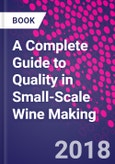As the wine industry has experienced a period of rapid global expansion, there is a renewed emphasis on quality and consistency even within the small winery industry. Written for the small production program, A Complete Guide to Quality in Small-Scale Wine Making is for the novice to intermediate level winemaker seeking foundational information in chemistry and sensory science as they relate to wine quality at a technical level.
Drawing from personal experience as well as scientific literature, this book introduces the core concepts of winemaking before delving into methods and analysis to provide practical insights into creating and maintaining quality in the wine product.
Table of Contents
1. Introduction to the Table Winemaking Process 2. Flavours and aromas in foods and beverages 3. Wine Chemistry 4. Safety 5. Table wine production 6. Microbiology & Methods 7. Harvest Protocols 8. Winery Protocols 9. Principals of analysis 10. Essential analyses 11. Quality assurance, teaching and research 12. Sample statistics








